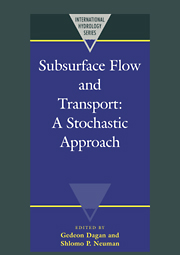Book contents
- Frontmatter
- Contents
- List of contributors
- Preface
- Acknowledgments
- I INTRODUCTION
- 1 Stochastic modeling of flow and transport: the broad perspective
- II SUBSURFACE CHARACTERIZATION AND PARAMETER ESTIMATION
- III FLOW MODELING AND AQUIFER MANAGEMENT
- IV TRANSPORT IN HETEROGENEOUS AQUIFERS
- V FRACTURED ROCKS AND UNSATURATED SOILS
- VI A VIEW TO THE FUTURE
1 - Stochastic modeling of flow and transport: the broad perspective
Published online by Cambridge University Press: 04 December 2009
- Frontmatter
- Contents
- List of contributors
- Preface
- Acknowledgments
- I INTRODUCTION
- 1 Stochastic modeling of flow and transport: the broad perspective
- II SUBSURFACE CHARACTERIZATION AND PARAMETER ESTIMATION
- III FLOW MODELING AND AQUIFER MANAGEMENT
- IV TRANSPORT IN HETEROGENEOUS AQUIFERS
- V FRACTURED ROCKS AND UNSATURATED SOILS
- VI A VIEW TO THE FUTURE
Summary
INTRODUCTION
Stochastic modeling of subsurface (unsaturated and saturated zones) flow and transport has become a subject of wide interest and intensive research in the last two decades. In principle, this approach recognizes that hydrological variables are affected by uncertainty and regards them as random. This randomness leads to defining models of flow and transport in a stochastic context, and predictions are made in terms of probabilities rather than in the traditional deterministic framework.
This approach is not new and was adopted by many disciplines in physics and engineering a long time ago. The closest field is of course that of surface hydrology, which relies traditionally on time series analysis in predicting floods and other extreme events. However, subsurface modeling deals mainly with spatial variability, the uncertainty of which is of a more complex nature. Besides, the physics of the phenomena is accounted for through the differential equations of flow and transport and various constitutive equations. These equations, regarded as stochastic, are intended to provide a general theoretical framework, rather than particular, empirical, statistical procedures. In this respect the subject is closer in outlook and methodology to the advanced statistical theories of continuum mechanics and of solid state physics.
It is beyond the scope of this presentation to attempt to review the various applications of stochastic modeling or even to try to cover the specific area of subsurface flow that was discussed in depth in the Colloquium. Instead, we shall try to discuss a few issues of principle, which are probably analyzed to a lesser extent in the following chapters.
- Type
- Chapter
- Information
- Subsurface Flow and TransportA Stochastic Approach, pp. 3 - 20Publisher: Cambridge University PressPrint publication year: 1997
- 5
- Cited by

